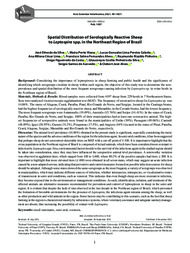Spatial distribution of serologically reactive sheep to Leptospira spp. in the northeast region of Brazil.
Spatial distribution of serologically reactive sheep to Leptospira spp. in the northeast region of Brazil.
Author(s): SILVA, J. D. da; VIANA, M. P.; CALADO, L. G. L. P.; LIMA, A. M. C.; ALVES, F. S. F.; PINHEIRO, R. R.; COSTA, D. F. da; SILVA, G. C. P. da; AZEVEDO, S. S. de; ALVES, C. J.
Summary: Background: Considering the importance of leptospirosis in sheep farming and public health and the significance of identifying which serogroups circulate in sheep within each region, the objective of this study was to determine the seroprevalence and spatial distribution of the most frequent serogroups causing infection by Leptospira sp. in ovine herds in the Northeast region of Brazil. Materials, Methods & Results: Blood samples were collected from 4197 sheep from 229 herds in 7 Northeastern States. Sera were analyzed via microscopic agglutination test (MAT). The frequency of seroreactive sheep for Leptospira sp. was 14.06%. The states of Alagoas, Ceará, Paraíba, Piauí, Rio Grande do Norte, and Sergipe, located in the Caatinga biome, had the highest frequencies of serologically reactive sheep, and Maranhão, in the Cerrado biome, had the lowest frequency. The most frequent serogroups were Autumnalis (19.49%), Australis (15.76%) and Serjoe (14.41%). In the states of Ceará, Paraíba, Rio Grande do Norte, and Sergipe, 100% of their municipalities had at least one seroreactive animal. The highest frequencies of seropositive animals were found in the municipalities of União (50%), Passagem (49.06%), Canindé (48.89%), Igaci (28.95%), Gararu (31.2%), Pirapemas (17.5%), and Angicos (16%) located in the states of Piauí, Paraíba, Ceará, Alagoas, Sergipe, Maranhão and Rio Grande do Norte, respectively. Discussion: The animal-level prevalence (14.06%) obtained in the present study is significant, especially considering the rustic nature of the species and the adverse conditions of the region for the infectious agent. In semi-arid conditions, it has been suggested that perhaps sheep do not seroconvert detectable titers on MAT with a cut-off point of 1:100. It is important to highlight that the ovine population in the Northeast region of Brazil is composed of mixed animals, which have been considered more resistant to infection by Leptospira spp. Also, environmental factors hostile to the survival of the infectious agent in the studied region should be taken into consideration, since they may have influenced the seropositive animal-level prevalence. A noteworthy variation was observed in agglutinin titers, which ranged from 100 to 1,600, where 80.2% of the positive samples had titers ? 200. It is important to highlight that more elevated titers (? 400) were obtained in all seven states, which may suggest an acute infection caused by a non-adapted serovar, indicating that preventive and control measures focused on possible infection sources for sheep should be adopted. Although some states showed the same serogroups as the most frequent, a variety of serogroups was observed in municipalities, which may indicate different sources of infection, whether interspecies, intraspecies, or via alternative routes of transmission in semi-arid conditions, such as venereal. This indicates that even though sheep are more resistant to infection, they become exposed due to the environment or management conditions. As such, identification, isolation, and treatment of the affected animals are alternative measures recommended for prevention and control of leptospirosis in sheep in the semi-arid region. It is evident that despite the lack of rain observed in the last decade in the Northeast region of Brazil, which prevented the formation of favorable environments for the presence of Leptospira, the infectious agent remains among the sheep, as well as other production and wild animals in the region. Some factors may be contributing to this scenario, such as the fact that sheep farming in the region is characterized mainly by subsistence systems, where veterinary assistance and adequate sanitary management are absent, thus increasing the possibility of contact with Leptospira.
Publication year: 2021
Types of publication: Journal article
Unit: Embrapa Goats & Sheep
Observation
Some of Embrapa's publications are published as ePub files. To read them, use or download one of the following free software options to your computer or mobile device. Android: Google Play Books; IOS: iBooks; Windows and Linux: Calibre.
Access other publications
Access the Agricultural Research Database (BDPA) to consult Embrapa's full library collection and records.
Visit Embrapa Bookstore to purchase books and other publications sold by Embrapa.

